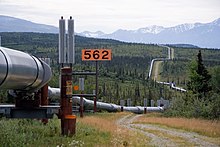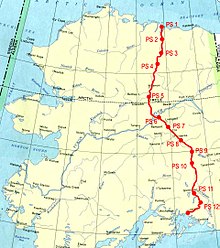Trans-Alaska Pipeline
| Trans-Alaska Pipeline System | |
|---|---|

The trans-Alaska oil pipeline, as it zig-zags across the landscape
|
|

Location of trans-Alaska pipeline
|
|
| Location | |
| Country | Alaska, United States |
| Coordinates | 70°15′26″N 148°37′8″W / 70.25722°N 148.61889°WCoordinates: 70°15′26″N 148°37′8″W / 70.25722°N 148.61889°W |
| General direction | North-South |
| From | Prudhoe Bay, Alaska |
| Passes through |
Deadhorse Delta Junction Fairbanks Fox Glennallen North Pole |
| To | Valdez, Alaska |
| Runs alongside |
Dalton Highway Richardson Highway Elliott Highway |
| General information | |
| Type | Pump stations |
| Owner | Alyeska Pipeline Service Company |
| Partners |
BP ConocoPhillips Exxon Mobil Koch Industries Chevron Corporation |
| Commissioned | 1977 |
| Technical information | |
| Length | 800 mi (1,300 km) |
| Maximum discharge | 2.136 MMbbl/d (339,600 m3/d) |
| Diameter | 48 in (1,219 mm) |
| Number of pumping stations | 12 |
The Trans-Alaska Pipeline System (TAPS) includes the trans-Alaska crude-oil pipeline, 12 pump stations, several hundred miles of feeder pipelines, and the Valdez Marine Terminal. TAPS is one of the world's largest pipeline systems. It is commonly called the Alaska pipeline, trans-Alaska pipeline, or Alyeska pipeline, (or the pipeline as referred to in Alaska), but those terms technically apply only to the 800 miles (1,287 km) of the pipeline with the diameter of 48 inches (122 cm) that conveys oil from Prudhoe Bay, to Valdez, Alaska. The crude oil pipeline is privately owned by the Alyeska Pipeline Service Company.
The pipeline was built between 1974 and 1977 after the 1973 oil crisis caused a sharp rise in oil prices in the United States. This rise made exploration of the Prudhoe Bay oil field economically feasible. Environmental, legal, and political debates followed the discovery of oil at Prudhoe Bay in 1968, and the pipeline was built only after the oil crisis provoked the passage of legislation designed to remove legal challenges to the project.
In building the pipeline, engineers faced a wide range of difficulties, stemming mainly from the extreme cold and the difficult, isolated terrain. The construction of the pipeline was one of the first large-scale projects to deal with problems caused by permafrost, and special construction techniques had to be developed to cope with the frozen ground. The project attracted tens of thousands of workers to Alaska, causing a boomtown atmosphere in Valdez, Fairbanks, and Anchorage.
The first barrel of oil traveled through the pipeline in 1977, and full-scale production began by the end of the year. Several notable incidents of oil leakage have occurred since, including those caused by sabotage, maintenance failures, and bullet holes. As of 2010, the pipeline had shipped almost 16 billion barrels (2.5×109 m3) of oil.
...
Wikipedia
